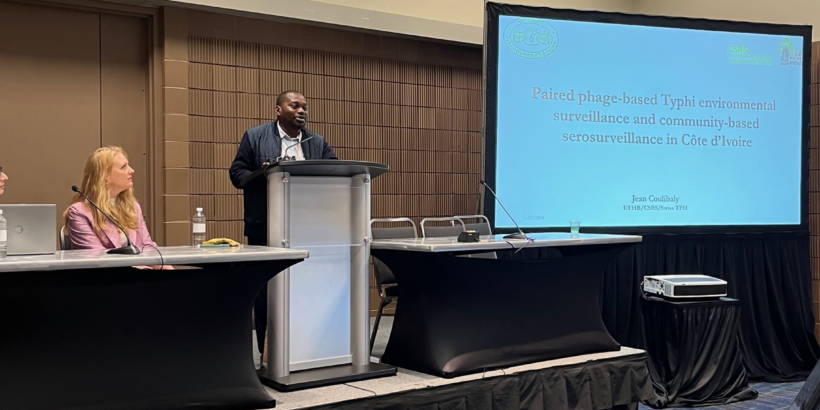Pour lire ce blog en français, veuillez cliquer ici
On Sunday, November 17, the Sabin Vaccine Institute hosted a symposium titled “Closing the Typhoid Surveillance Gap: Operationalizing Novel Surveillance Methods to Describe Enteric Fever Burden and Support Vaccine Decision-Making” during the American Society of Tropical Medicine and Hygiene Annual Meeting. The symposium highlighted advancements in typhoid surveillance and the use of low-cost, scalable tools to estimate disease burden in settings where blood-culture-based methods are not feasible. The panelists focused on novel methods to detect enteric fever transmission and disease burden while speaking to critical data gaps in traditional surveillance approaches. Dr. Jean Coulibaly, Associate Professor at Biosciences faculty at the Université Félix Houphouët-Boigny presented on paired phage-based Typhi environmental surveillance and community-based serosurveillance in Côte d’Ivoire.
Environmental surveillance and monitoring
Traditionally, enteric fever surveillance relies on blood-culture and many typhoid-endemic countries lack the resources and capacity to make high-quality blood-culture testing widely available. Without blood-culture-confirmed typhoid case data, it is difficult to measure typhoid burden, leading to many cases going undiagnosed and underreported. To overcome these challenges, researchers are turning to novel surveillance methods. One such method to monitor typhoid within a community is phage-based detection. Bacteriophages are viruses that infect specific bacteria. If a Salmonella Typhi bacteriophage is detected in a water sample, the bacterium is also likely present in the environment where the sample was collected. This means that scientists may be able to detect signs of typhoid in sewage and water sources, providing an indication of local typhoid transmission without relying on clinical data. This early detection can serve as a warning sign to prevent potential outbreaks by allowing public health officials to respond proactively and target areas where transmission is likely occurring.
Another new method measure enteric fever disease burden is community-based serosurveillance. By testing finger-prick blood samples for antibodies to S. Typhi, this method estimates the number of individuals recently exposed to the bacteria, regardless of whether they exhibit any symptoms. In a population with a high disease burden, more people will have high antibody levels, indicating frequent exposure to the pathogen. In Côte d’Ivoire, community-based serosurveillance has been a valuable tool to begin to understand typhoid burden in two health districts: the economic capital, Abidjan, and rural Azaguié. By analyzing the antibody levels in the population, we gain a clearer understanding of the incidence of past infections and identify areas where vaccination or improved water and sanitation interventions may be needed.
A combined approach for more accurate disease burden estimation
Using phage-based environmental surveillance alongside community-based serosurveillance offers a compelling method to better understand typhoid transmission and estimate disease burden. This combined approach allows us to monitor S. Typhi’s presence in the environment while assessing the population’s immune response to the bacteria. In Côte d’Ivoire, this method has identified typhoid hotspots, helping inform public health strategies and identify areas needing intervention. The risk of typhoid is high as 30% of the population lacks access to safe drinking water and 65% lacks standard sanitation facilities. However, by using environmental and seroincidence surveillance, researchers are gaining deeper insights into the infection patterns observed in the community. These innovative methods offer a useful approach for the potential to establish a typhoid fever surveillance-response system.
As countries like Côte d’Ivoire implement these innovative surveillance methods, they offer a hopeful outlook for other communities where blood-culture-based surveillance is not feasible. They further highlight the innovative approaches that are available to piece together a more comprehensive understanding of local typhoid burden and to identify disease hotspots. By addressing the gaps in traditional surveillance systems, these novel tools enhance our ability to respond to outbreaks and play a crucial role in shaping the future of typhoid prevention.
Photo: Dr. Jean Coulibaly presenting during the 2024 ASTMH Annual Meeting. Credit: Sabin Vaccine Institute



